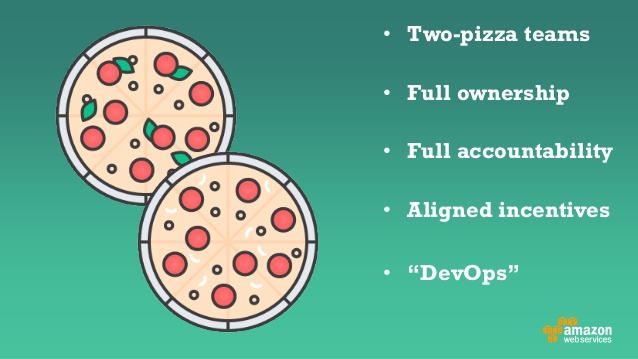The two-pizza team rule states that a team should only include as many people as two pizzas can feed.
Effective communication is the key to enhancing team productivity, and hence, in an Amazon offsite managers stressed upon a suggestion that employees should increase communication with each other. However, to everyone’s surprise founder and CEO, Jeff Bezos, turned it down saying, “No. Communication is terrible!”
He was of the view that more communication does not ensure team effectiveness, rather, it is the quality of communication that makes a difference. The concept of ‘two pizza team’ was then conceived as a solution to this challenge. The two-pizza team rule states that a team should only include as many people as two pizzas can feed.
“The two-pizza team concept is embedded in our culture and it works well for us because we believe in providing our people a sense of ownership and customer obsession. This is possible with the two-pizza team, as it is non-hierarchical, nimble and effective in motivating people to innovate.”
Raj Raghavan
The practical application of the two-pizza rule also makes sense if one compares how people communicate in large gatherings, such as a wedding, compared to how they communicate in a group of five or six. Since large groups do not allow people to have effective one to one communication with others, people start grouping into smaller clusters even at the weddings.
This is the case in the workplaces as well, where conclusions may be difficult to reach in a meeting involving more than 10 people.
For Amazon, innovating on behalf of the customer is at the core and the two-pizza team rule is an effective way to empower employees to innovate and be able to resolve customer needs faster and better.
Raj Raghavan, head-human resources, Asia Pacific Region at Amazon says, “The two-pizza team concept is embedded in our culture and it works well for us because we believe in providing our people a sense of ownership and customer obsession. This is possible with the two-pizza team, as it is non-hierarchical, nimble and effective in motivating people to innovate.”

While the accountability levels certainly drop with the growing number of employees in a team, at the same time, the feeling of being heard and being a crucial contributor is also lost in the mechanical controls that larger teams would involve.
Abhijit Bhaduri, founder, Abhijit Bhaduri & Associates and ex-CLO, Wipro, says, “Accountability gets diffused in larger teams. On the other hand, with smaller teams, setting up meetings or connecting in person gets easier.”
“The interdependencies of the team members, their locations and level of communication involved are a few other complexities that contribute to the team dynamics. Nevertheless, a team size of six to eight is optimum for ensuring effective communication. It also means that there is a better understanding of the interdependencies in the team.”
Kamlesh Dangi
He also shares that smaller teams make decision making and implementation quicker and smoother, thereby reducing the turnaround time. This, in turn, proves to be a huge business benefit in the long run.
Traditionally as well, it is believed that a manager should not have more than six to eight reportees. Kamlesh Dangi, group president, HR at UTI MF believes that team effectiveness is not just dependent on the number of members but various other factors.
“The interdependencies of the team members, their locations and level of communication involved are a few other complexities that contribute to the team dynamics. Nevertheless, a team size of six to eight is optimum for ensuring effective communication. It also means that there is a better understanding of the interdependencies in the team,” he says.
“Smaller teams make decision making and implementation quicker and smoother, thereby reducing the turnaround time. This, in turn, proves to be a huge business benefit in the long run.”
Abhijit Bhaduri
Bhaduri believes that more than the number itself, what matters most is that the five to six people in a small team are able to bring in a diversity of thought. Research has also proved that larger teams foster overconfident people.
Researchers Bradley Staats, Katherine Milkman, and Craig Fox say that people tend to increasingly underestimate task completion time as team size grows.
In fact, in one of their experiments, they discovered that when tasked to build the same Lego figure, two-person teams took 36 minutes, while four-person teams took 52 minutes to finish — over 44 per cent longer.
Now for the perfect two-pizza team, Bezos’ concept works best for up to six or seven people. Some other experts warn against exceeding 10. It is about having people who can work together towards the same goal.




1 Comment
( gd article. Yes the smaller team increases affective, speedy communication and brings more accountability.
They need to be empowered sufficiently for decision making. If decesion making is above the 2 levels of proposing level it slows down the speed nd with that motivation gets lower.
The executive should not hv reporting executives more than 5/6 max. Or lese the attention of decision maker is devded and more diversified opinions slows the process.
Yes the smaller teams means many teams and they should be properly balanced teamslike enthusism, speed, maturirity and objective towrds companies goals.